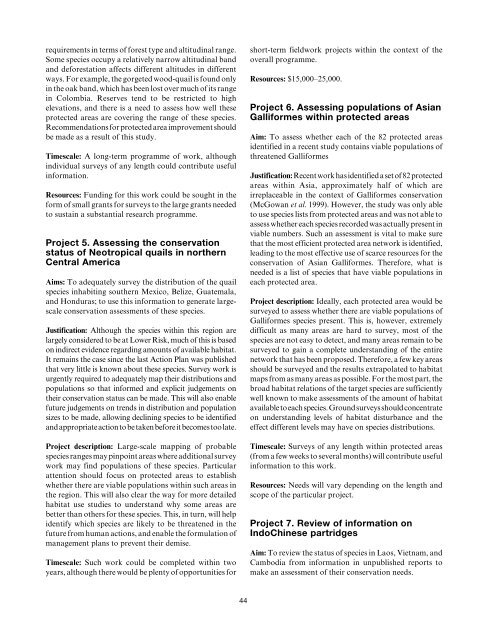Partridges, Quails, Francolins, Snowcocks, Guineafowl, and Turkeys
Partridges, Quails, Francolins, Snowcocks, Guineafowl, and Turkeys
Partridges, Quails, Francolins, Snowcocks, Guineafowl, and Turkeys
You also want an ePaper? Increase the reach of your titles
YUMPU automatically turns print PDFs into web optimized ePapers that Google loves.
equirements in terms of forest type <strong>and</strong> altitudinal range.<br />
Some species occupy a relatively narrow altitudinal b<strong>and</strong><br />
<strong>and</strong> deforestation affects different altitudes in different<br />
ways. For example, the gorgeted wood-quail is found only<br />
in the oak b<strong>and</strong>, which has been lost over much of its range<br />
in Colombia. Reserves tend to be restricted to high<br />
elevations, <strong>and</strong> there is a need to assess how well these<br />
protected areas are covering the range of these species.<br />
Recommendations for protected area improvement should<br />
be made as a result of this study.<br />
Timescale: A long-term programme of work, although<br />
individual surveys of any length could contribute useful<br />
information.<br />
Resources: Funding for this work could be sought in the<br />
form of small grants for surveys to the large grants needed<br />
to sustain a substantial research programme.<br />
Project 5. Assessing the conservation<br />
status of Neotropical quails in northern<br />
Central America<br />
Aims: To adequately survey the distribution of the quail<br />
species inhabiting southern Mexico, Belize, Guatemala,<br />
<strong>and</strong> Honduras; to use this information to generate largescale<br />
conservation assessments of these species.<br />
Justification: Although the species within this region are<br />
largely considered to be at Lower Risk, much of this is based<br />
on indirect evidence regarding amounts of available habitat.<br />
It remains the case since the last Action Plan was published<br />
that very little is known about these species. Survey work is<br />
urgently required to adequately map their distributions <strong>and</strong><br />
populations so that informed <strong>and</strong> explicit judgements on<br />
their conservation status can be made. This will also enable<br />
future judgements on trends in distribution <strong>and</strong> population<br />
sizes to be made, allowing declining species to be identified<br />
<strong>and</strong> appropriate action to be taken before it becomes too late.<br />
Project description: Large-scale mapping of probable<br />
species ranges may pinpoint areas where additional survey<br />
work may find populations of these species. Particular<br />
attention should focus on protected areas to establish<br />
whether there are viable populations within such areas in<br />
the region. This will also clear the way for more detailed<br />
habitat use studies to underst<strong>and</strong> why some areas are<br />
better than others for these species. This, in turn, will help<br />
identify which species are likely to be threatened in the<br />
future from human actions, <strong>and</strong> enable the formulation of<br />
management plans to prevent their demise.<br />
Timescale: Such work could be completed within two<br />
years, although there would be plenty of opportunities for<br />
short-term fieldwork projects within the context of the<br />
overall programme.<br />
Resources: $15,000–25,000.<br />
Project 6. Assessing populations of Asian<br />
Galliformes within protected areas<br />
Aim: To assess whether each of the 82 protected areas<br />
identified in a recent study contains viable populations of<br />
threatened Galliformes<br />
Justification: Recent work has identified a set of 82 protected<br />
areas within Asia, approximately half of which are<br />
irreplaceable in the context of Galliformes conservation<br />
(McGowan et al. 1999). However, the study was only able<br />
to use species lists from protected areas <strong>and</strong> was not able to<br />
assess whether each species recorded was actually present in<br />
viable numbers. Such an assessment is vital to make sure<br />
that the most efficient protected area network is identified,<br />
leading to the most effective use of scarce resources for the<br />
conservation of Asian Galliformes. Therefore, what is<br />
needed is a list of species that have viable populations in<br />
each protected area.<br />
Project description: Ideally, each protected area would be<br />
surveyed to assess whether there are viable populations of<br />
Galliformes species present. This is, however, extremely<br />
difficult as many areas are hard to survey, most of the<br />
species are not easy to detect, <strong>and</strong> many areas remain to be<br />
surveyed to gain a complete underst<strong>and</strong>ing of the entire<br />
network that has been proposed. Therefore, a few key areas<br />
should be surveyed <strong>and</strong> the results extrapolated to habitat<br />
maps from as many areas as possible. For the most part, the<br />
broad habitat relations of the target species are sufficiently<br />
well known to make assessments of the amount of habitat<br />
available to each species. Ground surveys should concentrate<br />
on underst<strong>and</strong>ing levels of habitat disturbance <strong>and</strong> the<br />
effect different levels may have on species distributions.<br />
Timescale: Surveys of any length within protected areas<br />
(from a few weeks to several months) will contribute useful<br />
information to this work.<br />
Resources: Needs will vary depending on the length <strong>and</strong><br />
scope of the particular project.<br />
Project 7. Review of information on<br />
IndoChinese partridges<br />
Aim: To review the status of species in Laos, Vietnam, <strong>and</strong><br />
Cambodia from information in unpublished reports to<br />
make an assessment of their conservation needs.<br />
44

















